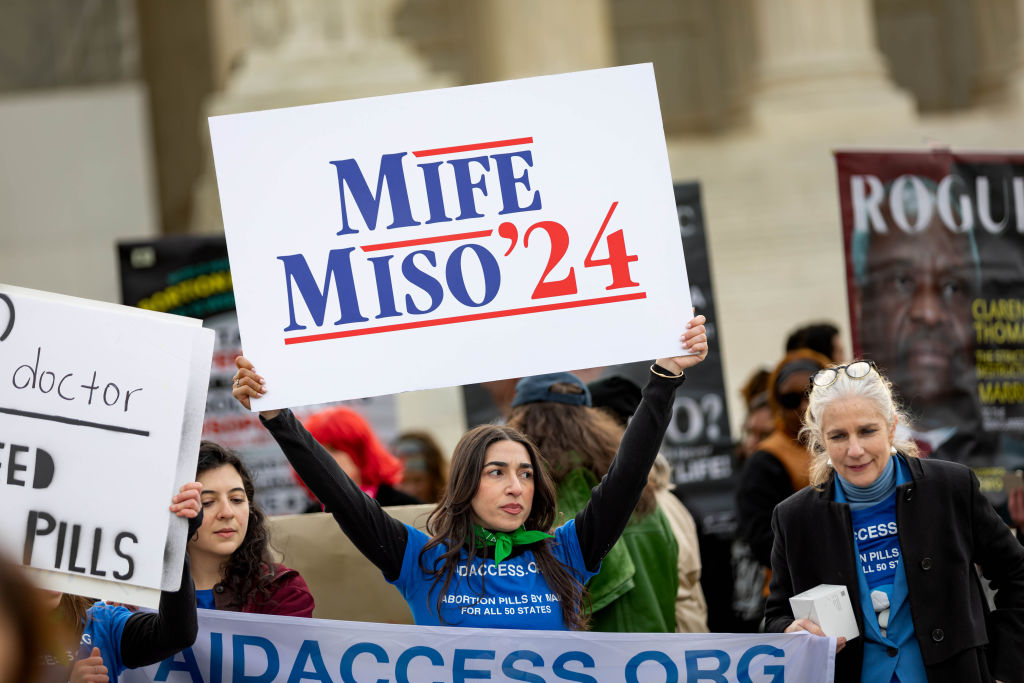Pro-Choice
Related: About this forumSo Goes Reproductive Freedom, So Goes Democracy
So Goes Reproductive Freedom, So Goes Democracy
PUBLISHED 5/13/2024 by Laleh Ispahani and Jennifer Weiss-Wolf
Bodily autonomy is inextricably linked to the integrity and durability of the body politic—with threats to one reinforcing threats to the other.

Pro-abortion demonstrators outside the U.S. Supreme Court on March 26, 2024, as the Court hears arguments on whether to limit the use of mifepristone, a medication that’s used in nearly two-thirds of all abortions nationally. (Michael Nigro / Pacific Press / LightRocket via Getty Images)
When people consider what it means to be a democracy on the decline, plot points of the recent film Civil War come to mind: a U.S. president who disregards the Constitution to nab a third term. Crackdowns on dissent and the media. Leaders using the military to break up public demonstrations. While that is, of course, representative of growing authoritarianism, recent history suggests that rollbacks on bodily autonomy and reproductive freedoms are also flashing red lights for would-be regimes. Elected authoritarians undermine the rule of law by positioning themselves as defenders of traditional values, spreading misinformation, and stacking the judiciary with their political allies.
The standing of the United States among modern democracies also has continued to ebb. The capture of the federal courts and installation of a supermajority on the U.S. Supreme Court not only sounded the death knell for Roe v. Wade but ushered in the chaotic judicial aftermath we are now experiencing—with not one but two abortion cases back on the Court’s docket this term. The anti-democratic through-line points toward fissures in other aspects of free and fair representation. A majority (67 percent) of Americans who live in states where abortion is banned want the procedure to be legal; that can only be seen as an abject failure of democratic systems and structures. This is further reflected in states where abortion has been on the ballot (going six-for-six); people overwhelmingly voted to restore abortion rights where gerrymandered legislatures would have otherwise passed and enforced bans. Moreover, the introduction of nearly 400 anti-trans bills in state legislatures across the country hardly reflects the priorities and will of the majority of voters. Reproductive rights do not exist in a vacuum. Bodily autonomy is inextricably linked to the integrity and durability of the body politic—with threats to one reinforcing threats to the other. Targeting women leaders like Maria Ressa and Suyen Barahona, has proved a powerful political tool for illiberal leaders, a bargaining chip that not only helps them gain power but consolidate and maintain it.
. . . .
“Misogyny and authoritarianism are not just common comorbidities but mutually reinforcing ills,” writes Harvard Kennedy School’s (and Ms. contributor) Erica Chenoweth. In other words, leveraging these in tandem is a key tactic in the authoritarian playbook. “Aspiring autocrats and patriarchal authoritarians have good reason to fear women’s political participation. [F]ully free, politically active women are a threat to authoritarian and authoritarian-leaning leaders—and so those leaders have a strategic reason to be sexist,” Chenowith writes. In the United States, philanthropic support for democracy and for girls, women, and LGBTQ people encompasses a tiny fraction of total investment dollars. So how do we ensure that this nexus is addressed and adequately supported?
In our respective roles—as head of the U.S. program for Open Society Foundations and a feminist advocate and writer—we’ve got some ideas. First, pro-democracy funders simply must be deliberate and full-throated—in word and deed—that the fight for robust democratic structures and gender justice is one and the same. This simply means elevating these connections wherever and whenever one has influence whether it is in the media or the corridors of power. Raise your voice boldly. This also entails determining where reproductive and LGBTQ rights are on the line, mapping it with states fighting for voting rights and representation, and investing at the intersection of the two issues. For those supporting direct democracy initiatives in 2024—whether it is Florida’s abortion ballot measure or fair maps in Ohio—it means funding those efforts not just for a single win, but to harness momentum in those communities and coalitions that builds lasting democratic reforms. Here’s the main takeaway—so well-articulated by our colleague Pamela Shifman, president of the Democracy Alliance: “The struggle for democracy and for gender, racial and economic justice is one fight. It’s our fight.”
https://msmagazine.com/2024/05/13/reproductive-freedom-democracy-abortion-womens-rights/